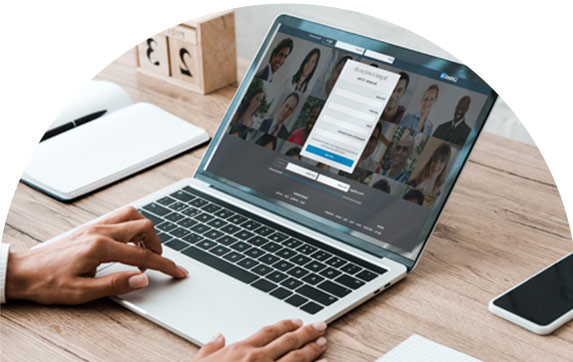We’re all doing one form of lead generation or another.
But, most of it is purely outbound.
How about if I told you that you can turn your LinkedIn profile into a passive inbound lead generation monster?
Yes, you read that right.
We’ll talk about the things that you can do to make sure that all your outbound campaigns on the platform are supported by a solid inbound lead generation campaign that you can add to any current strategy.
Why Should You Trust Me?
My name is Houston Golden, I’m the founder of BAMF, a marketing consultancy that specializes in growth hacking and LinkedIn optimization for different organization.
I started with literally “zero” until it grew to a multimillion-dollar agency.
Using in-house strategies and creative campaigns, I’ve managed to work with struggling startups, Fortune 500 companies, and people who are just trying to make it.
What I’m going to share with you today are hacks that we’ve used to grow many organizations.
The Landing Page Strategy
No, I’m not talking about creating a landing page on your website.
I’m talking about turning your profile into a landing page for your prospects.
Here’s what.
Your LinkedIn profile is basically the first thing that a prospect will see once their interest is piqued. It could be through a post that you’ve published or an outbound campaign that you’re running.
It doesn’t matter how creative your post is or how awesome your outbound efforts are.
If your profile doesn’t cut it, you could lose out on a potential deal.
You need to turn your profile into a proper landing page.
This means you need:
- Convincing content
- Great graphics
- CTA
- Tracking
- Proper Sections
- Social Proof
- And, of course, links
But, how can you do that on LinkedIn?
Easy.
Proper profile optimization and strategic posts.
Let’s get into each part in detail.
Major Parts of Your Profile
- Profile Photo – Your photo has to make you look trustworthy, you can run it through an app like Snappr or ask a colleague to check it out. You don’t have to smile, you don’t need to be in a suit – even I don’t wear one, you just need to look competent for the role you’re in.
- Cover Photo – this is a sweet piece of virtual real estate. You want to treat this the way you treat content and graphics that are above the fold on your website. Don’t just upload a company photo. Edit it, add your handle, showcase your products, put in some CTA, etc. There are so many different combinations of factors that you can use!
- Headline – the first piece of marketing copy that your prospects will read about is your headline, so it’s the one part of your profile that you should spend the most time on. Remember, your headline also appears in search results. It has to be compelling, it has to be unique, and more importantly, drive conversions.
Make sure you include what you do, who you represent, and how you can help a prospect out, e.g., Growth Hacker Extraordinaire | Lead at Zopto | Consistently Driving Leads on LinkedIn
- About Summary – I’ve talked about this in detail on our own blog on BAMF but what you have to know is that this forms the major bulk of your content in the “landing page strategy”.
There are many ways to structure your LinkedIn about summary, but the most important parts are the first three lines (since the rest of your summary gets cut off with an option for the prospect to see more, and the middle (where you convince prospects that you know what you’re doing).
For the beginning, I strongly advise that you put in your meeting link or email address so that prospects can contact you. In the middle, talk about why you’re on LinkedIn and how you can help the reader.
Experiences
I treat the Experiences section of my profile the same way that I treat my website service pages.
This section allows you to create little areas where you can showcase the different things you’re good at.
Here’s a pro tip.
Make sure you only feature three to five of the most significant experiences that you have. If you list down every single thing, there is a tendency that the smaller experiences might overshadow the ones that matter.
If you want to showcase just one organization, create different company pages for each division, and use those pages to create separate experiences.
Recommendations
You know how a lot of landing pages have testimonials baked into them?
They do that to increase the perceived integrity of the website.
It’s called social proof.
On LinkedIn there’s an area of your profile where recommendations about you can be made. You will want to get a couple of your colleagues or previous customers to recommend you.
This is a little tweak that can help boost trust.
After getting an initial round of recommendations – make sure they’re sincere, people can tell if you coerced people to talk about you – you can leave it be and just gather more organically.
The Lead Magnet Strategy
We all actively post on LinkedIn, whether it’s to update followers or as a form lead nurturing (we’ll talk about this in a while) but one of the most effective posts are lead magnets.
Lead magnets are designed to go viral, but they rely on giving something away that can give value to the prospect.
This is what you should do:
- Create a post offering something of value to your followers, e.g. a template, calculator, dashboard, spreadsheet, case study, etc.
- Invite them to comment on the post so that you can either: send them the giveaway personally or send them the link to the giveaway hosted on your website.
- Get in a LinkedIn pod to give it some extra engagement.
- Watch the number of your leads grow.
This strategy has allowed us to go viral multiple times because LinkedIn gauges the virality of the content based on how many engagements it has. The more comments you have, the more LinkedIn will put your content in front of more people.
Also, since the link has to go through a “gate” you don’t have to put out your link anywhere in the post minimizing the chance of LinkedIn penalizing you.
There is also the prequalification aspect, you only get comments from people who are genuinely interested. And, you get to be relational with them since you contact them directly.
Note: If you’re going to host the link on your website, make sure that you send them to a landing page that is being tracked with a UTM on Analytics.
You can’t growth hack if you don’t track.
Adding a Third-Party
LinkedIn pods are not the only third-party hack that we have to generate inbound leads, another way we do it is using Facebook, but it relies on having prospects’ emails ready.
This is how you do it:
- Create a custom audience on Facebook Ads using a targeted email list
- Place in an ad that doesn’t sell but serves as brand recall
- Run the ad
Alternatively, you can also do this with a Facebook Pixel if you managed to create a landing page on your website for your post giveaway on LinkedIn.
The reason we like this is because it promotes a “softer” sell without actively having to do anything.
Pushing for brand recall is usually more than enough to supplement the posts that prospects see and any direct campaign that you’re running.
Automating It
Lastly, is minimizing the active work that you do on your outbound campaigns, through automation.
Now there are a lot of apps out there but one of the best that we’ve seen is Zopto.
They allow you automated prospecting solutions, combined with a cloud-based service that helps minimize being penalized by the platform.
We’ve found that it even helps with targeted campaign prospecting, which is a great feature to have especially if you want to combine both outbound and inbound lead generation.
Takeaways
I’m all for outbound lead generation, but having an inbound lead generation strategy will do wonders for your conversions.
Passive lead generation doesn’t take more than two hours to set up and it uses no effort in bringing in leads afterwards.
Growth hacking isn’t just about working the hardest, but being as efficient as possible with the resources that you have.
Don’t put your profile to waste and your posts to waste.
Use them as a secondary funnel for your leads.
How do I add skills to my LinkedIn profile?
To add skills to your LinkedIn profile, go to the ‘Skills & Endorsements’ section in your profile, click on ‘Add a new skill’, then type in the skill you want to add.
How do I customize my LinkedIn URL?
To customize your LinkedIn URL, go to your profile, click ‘Edit public profile & URL’ on the right, under ‘Edit URL’, click the ‘Edit’ icon, then type the last part of your new custom URL.

